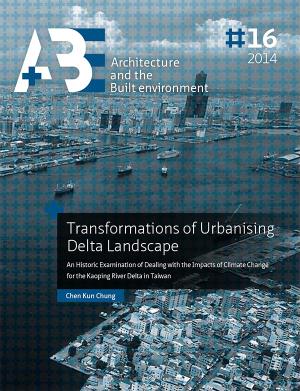Hosted by
Transformations of Urbanising Delta Landscape: An Historic Examination of Dealing with the Impacts of Climate Change for the Kaoping River Delta in Taiwan
Synopsis
This dissertation argues that the floods following extreme precipitation result notˬonly from very heavy rainfall but also from the significant impact of human activities on natural water systems. While most literature emphasises that the increasing magnitude of storm rainfall extends beyond the original protection standards of hydrologic facilities in highly populated delta cities. Based on the knowledge of urban morphology, this study analyses how human systems have affected the transformation of natural water processes in the Kaoping River Delta. The relationship between human environments and natural landscape is illustrated via a 3-layer analytical framework which consists of a natural landscape layer, an infrastructure layer and an occupation layer. This layer-based approach views landscapes as a whole system in which each element interacts with the others. In order to transcend the limitations of traditional urban morphology and the overlay-mapping method, this research initiates an analysis framework with the delta scale from a deductive perspective. Furthermore,ˬit argues that the significant progress of infrastructure technology is the crucial factor to dominate the transformation of modern urban pattern. This influence could be identified by the analytic process of the 3-layer approach from the perspective of the delta or regional scale. This new starting point of a theoretical framework for analysing urban forms has been proved in the Kaoping Delta case. Furthermore, it could be a new and valid theoretical background to extend the knowledge of urban morphology.
The formal transformation of the Kaoping Delta is divided into four main periods, which reveals human activities have affected the operation of natural systems since a century ago. From a delta scale perspective, those effects interacting between different layers can be identified in six different topographies (in italics) of the whole river catchment area.
A. The dike system along the main stream in the plains protects delta cities against floods, which enables rapid urbanisation. Population growth in delta cities increases food demand, which causes the intensive agricultural cultivation of mountain areas.
B. The dike system narrows the original riverbed in the river basin, which raises the water level of the river during storms. This situation blocks the drainage outlets of delta cities and induces higher frequencies of urban inundations.
C. The dike system along the main stream in the plains has significantly changed the surface flowing path of river and dramatically decreased the recharge of groundwater in foothills. It causes serious land subsidence in coastal areas when the ground cannot obtain sufficient groundwater.
D. The dike system and the bridges of transportation crossing river has resulted in the lag-sedimentation of the river in the river basin. When a significant amount of river sand deposits in the riverbed rather than being transited to the estuary to supply the demand for sand along the coast, it induces serious erosion in the coast. À¨Following this context, this study organised a five day workshop in Kaohsiung, ‘Workshop on Water Environment Development in Kaohsiung’ in 2012 to further examine the results derived from Chapters 3 and 4, and to demonstrate how a 3-layer approach can work between multiple disciplines as a platform for collaboration.À¨This workshop followed the theoretical framework of the 3-layers to explore the entire Kaoping River catchment area and its two tributary basins as the chosen local-scale sites: the Meinong River and the Love River. This workshop gives the best demonstration of how to practically utilise the 3-layer approach to organise multiple- disciplinary work, and then to make an integrated plan. The results and process of this workshop are also generalised as a framework, which could be applied to other cases.

